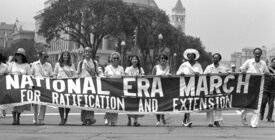The nearly 700,000 residents of Washington, DC, do not have full voting representation in Congress, even though they are American citizens, pay federal taxes, and serve in the military. This lack of political representation for the District of Columbia — which has more people than Vermont and Wyoming and historically a large Black population — is one way our political system disenfranchises and underrepresents voters of color. The federal government also exercises tremendous power over the district, without accountability to the residents whose lives are impacted.
Advocates have long pushed to cure this democratic deficit. After years of frustration, the movement recently reached an important milestone. In 2020 and again in 2021, the House passed H.R. 51, the Washington, DC Admission Act. If passed by the Senate and signed into law by the president, it would give voters in our nation’s capital the ability to participate fully in our democracy by admitting “Washington, Douglass Commonwealth,” as the 51st state.
What are the origins of DC’s lack of full voting representation?
The District Clause, found in Article I of the Constitution, empowered Congress to establish a federal capital district “not exceeding ten miles square” where it would “exercise exclusive legislation in all cases whatsoever.”
But the Framers made a fateful omission: They failed to provide a means for representation for the district’s future residents. In the Constitution, seats in Congress and votes in the Electoral College are all allocated among the states — but the district is not a state.
In its early years, the United States did not have a permanent capital, and Congress met in a few different cities. After President George Washington chose a location on the Potomac River for the permanent capital, the District of Columbia Organic Act of 1801 gave Congress exclusive jurisdiction over the district’s territory, robbing its residents of the voting rights they previously enjoyed as citizens of Maryland and Virginia.
What is the history of the movement for DC statehood and self-government?
Over many years, the district’s residents have campaigned to secure the same voting rights enjoyed by citizens of states. These efforts intensified during the civil rights era, leading to the movement’s first success. In 1960 Congress approved the 23rd Amendment, which allowed DC citizens to vote in presidential elections. The measure was ratified by the states in 1961. (An earlier version of the amendment, approved only by the Senate, would also have opened to door to voting representation in the House.)
Building on this success, reformers turned their sights on two new goals: gaining representation in Congress and reclaiming control over local affairs. The District of Columbia Delegate Act of 1970 allowed DC residents to elect a non-voting delegate to the House. The Home Rule Act of 1973 allowed them to elect their own mayor, as well as a 13-member city council.
And in 1979, the D.C. Voting Rights Amendment, which would have awarded DC the same status of a state — representation in both the House and the Senate as well as the constitutional amendment process — passed both houses of Congress by the necessary two-thirds majority. In the end, however, the measure was only ratified by 16 states, well short of the 38 needed to take effect.
Today, DC continues to lack a vote in Congress and is deprived of other attributes of statehood and full control of its own government.
How has DC’s status affected its residents?
The slogan “End Taxation Without Representation,” found on DC license plates, highlights one of the primary harms caused by the lack of voting representation in Congress. DC residents pay more in federal taxes per person than any other state — and more than 22 states in the aggregate.
Congress continues to exercise extensive authority over DC’s budget, retaining the right under the Home Rule Act to review and nullify any legislation passed by the district’s local government, with important consequences for DC residents. For instance, Congress continues to block the district’s ability to regulate and tax the market for cannabis, which was legalized by DC voters in 2014. Congress for years blocked other important DC policies, including a needle-exchange public health program and health insurance coverage for domestic partnerships.
Lacking voting representation in Congress also prevents the district from receiving its fair share of federal resources. When Congress passed a coronavirus relief package in March 2020, the district was shortchanged by millions of dollars in federal aid because it was treated as a U.S. territory and not a state.
While the local government oversees the DC Metropolitan Police Department, the DC National Guard reports to the president. This reporting structure is unlike those of all other National Guards, which report to their state or territorial governor. The consequences of this disparity became particularly stark during protests against police brutality following the murder of George Floyd: in June 2020, President Trump deployed DC National Guard troops to suppress a peaceful Black Lives Matter rally, a move regarded by many DC residents as a “hostile invasion.” Months later, amid the delayed law enforcement response to the Capitol insurrection on January 6, 2021, help would have likely arrived sooner if DC’s mayor had authority over the DC National Guard.
What is the Washington, DC Admission Act?
The bill would turn most of present-day Washington, DC, into a new state called Washington, Douglass Commonwealth. The new state would be on equal footing with the existing 50, with the same level of control over its own affairs and full voting representation in Congress, with two senators and one representative. A small capital district comprising the Capitol complex, White House, National Mall, and other federal grounds would remain under congressional authority as the seat of the federal government.
Can Congress admit DC as a state?
Yes. The Constitution vests Congress with broad power to admit new states through legislation under Article IV, subject to two limitations: states may not be formed from existing states’ territory without their consent and jurisdictions seeking to join the Union as states must have a republican form of government. Congress has historically applied two additional criteria when considering whether to admit a new state. Petitions for statehood must reflect the desire of the people in that jurisdiction, and any new state must have the sufficient population and resources to support itself and contribute to the federal government.
Admitting the Douglass Commonwealth as the 51st state through ordinary legislation is not only permissible but also consistent with how the other 37 non-original states were admitted, from Vermont in 1791 to Hawaii in 1959. The contention that the Washington, DC Admission Act is somehow different, in process or political effect, is not true.
Furthermore, Congress’s exclusive authority over the district includes the power to revise its boundaries under Article I. In 1846, Congress exercised this power to modify the district’s original “ten miles square” boundary, returning land previously ceded by Virginia. Courts have also found that the Constitution’s District Clause contains ”sweeping and inclusive” language, permitting broad leeway for Congress to alter the federal district’s contours.
What are arguments made against DC statehood?
Opponents have raised several arguments questioning the constitutionality of admitting the district as a state. Some argue that it requires the consent of Maryland, the state from which the land was originally granted. This view is contradicted by historical documentation showing that when Maryland ceded the territory, it stipulated that the land was “forever ceded and relinquished . . . in full and absolute right and exclusive jurisdiction.”
Furthermore, some have claimed that the 23rd Amendment prohibits statehood, because it authorizes Congress to grant electoral votes to the district. A group of nearly 40 prominent constitutional scholars persuasively argues otherwise. While it might be appropriate for Congress to repeal the 23rd Amendment once most of DC becomes a state, the amendment’s existence in no way precludes admitting DC as a new state.
Additionally, certain opponents to statehood claim that since prior efforts to grant the district’s residents full voting representation in Congress have sometimes taken the form of proposed constitutional amendments, statehood cannot be achieved through legislation. Yet there is no historical, constitutional, or legal basis for this claim. Many movements for change, like the fight to eliminate discrimination based on sex and gender through the Equal Rights Amendment, initially took the form of failed amendments whose protections subsequently became law.
Moreover, a crucial distinction is that where the unsuccessful 1979 statehood amendment effort reflected Congress’s attempt to give DC residents certain attributes of statehood (congressional representation) without actually making DC a state. The failure of this effort does not preclude admitting a new state through established processes provided under the Constitution, which is a straightforward legislative exercise.
Finally, opponents also claim that the district lacks the population and resources necessary for a state. Yet its population — over 670,000 as of 2021 — is roughly similar to that of seven states. The district has also demonstrated its ability to handle its own affairs.
What makes DC statehood a civil rights issue?
If admitted, DC would have the highest proportion of Black residents of any state. For decades, starting in the 1960s, the city had a majority Black population, still accounting for nearly half of its residents.
Disenfranchising Black voters has both explicitly and implicitly been part of the rationale against efforts to expand voting rights and representation throughout American history. Indeed, historians have documented how the debate over the disenfranchisement of DC residents has always been tied to the area’s racial demographics and Black political power. The arguments of past were often explicit — from the 1890s comment of Sen. John Taylor Morgan of Alabama describing the post-Reconstruction removal of local election rights as Congress “burn[ing] down the barn to get rid of the rats . . . the rats being the negro population,” to the 1970s assertion by Pat Buchanan that DC congressional representation would be an “affirmative action program.”
The exclusion of DC residents from a voice in Congress contributes to the underrepresentation of voters of color in the American political system. According to a New York Times analysis, based on the voting power of each U.S. senator, the average Black American receives “only 75 percent as much representation as the average white American.”
In fact, much of the opposition to DC statehood is purely partisan and too often echoes outdated, racially based arguments. Indeed, in 1978, Sen. Ted Kennedy (D-MA) attributed the resistance to granting DC full representation to “the fear that Senators elected from the District of Columbia may be too liberal, too urban, too Black or too Democratic.”
What is the outlook for DC statehood?
Statehood supporters reached an important milestone in June 2020 when the House voted for the first time to admit Douglass Commonwealth as a state, passing H.R. 51 by a vote of 232 to 180. It approved the measure again in April 2021 by the narrower margin of 216 to 208. Both votes fell almost entirely along party lines, garnering no Republican support. While the Senate has not taken up the measure, there is significant GOP opposition there too — the Senate bill has only Democratic co-sponsors, and Republican senators criticized the bill in a June 2021 committee hearing, often in jarringly partisan terms.
There has not always been a partisan split on the issue. The goal of extending voting representation to the district earned bipartisan support, including from key Republican leaders. In 1968, President Richard Nixon argued that the lack of a voice in Congress for DC residents “should offend the democratic sense of this nation.” As it became clear that the district’s voters were likely to send Democrats to Congress, Republican support began to erode. But as wider voting patterns change, this could shift as it has in other states.
Yet voting rights for DC residents shouldn’t depend on who they vote for. DC statehood is crucial for ensuring all eligible Americans the full franchise. Alongside other federal-level democratic reforms, it is a necessary part of giving every American a meaningful say in the rules that govern their lives.







